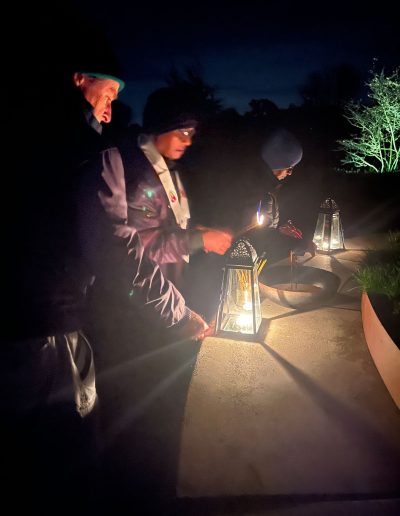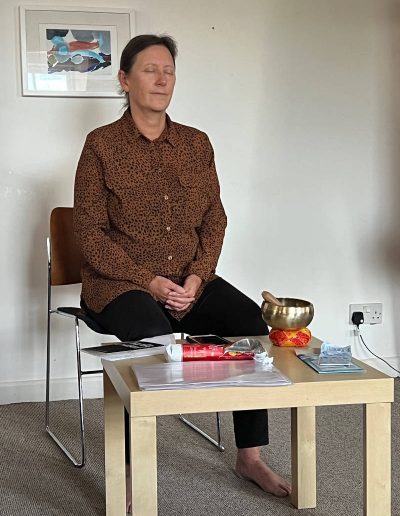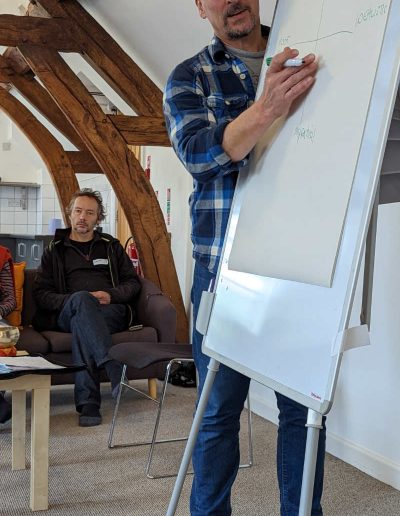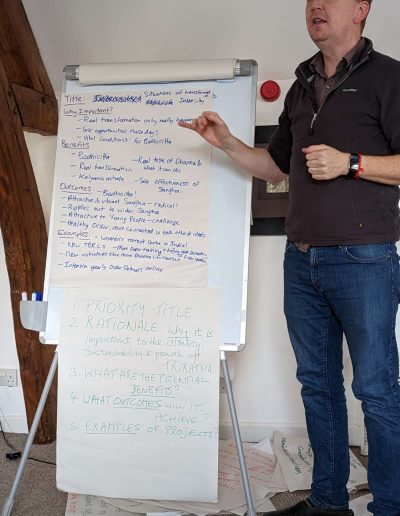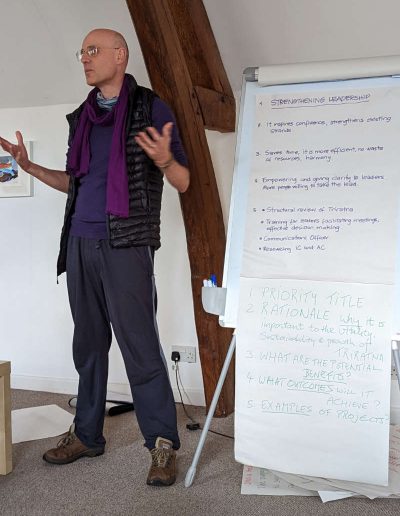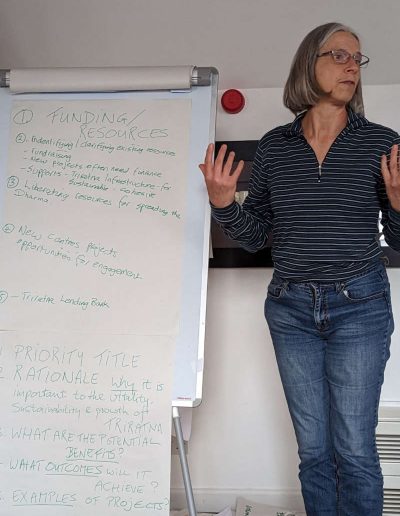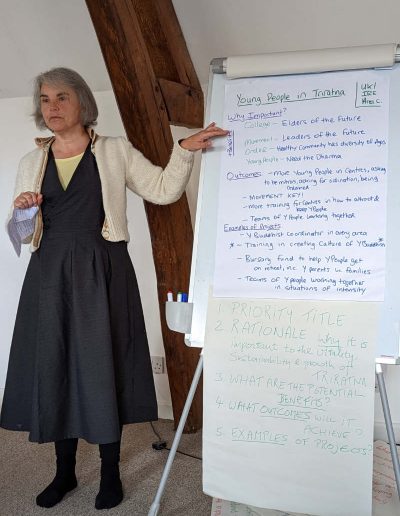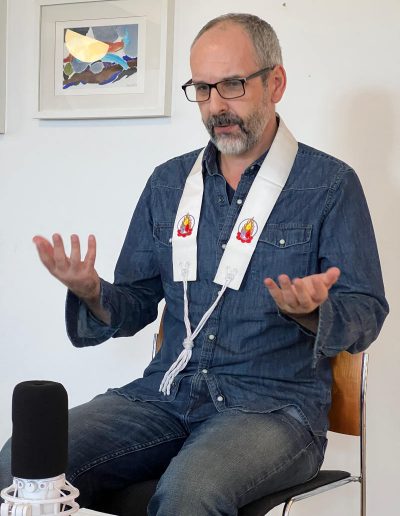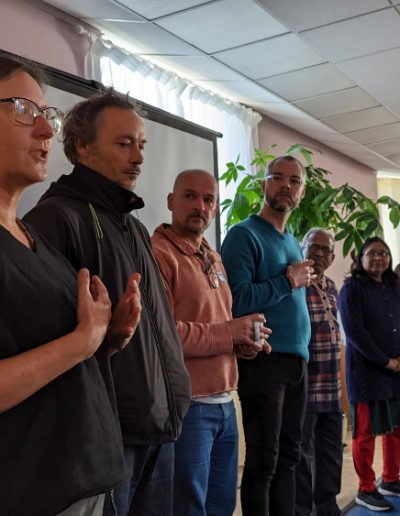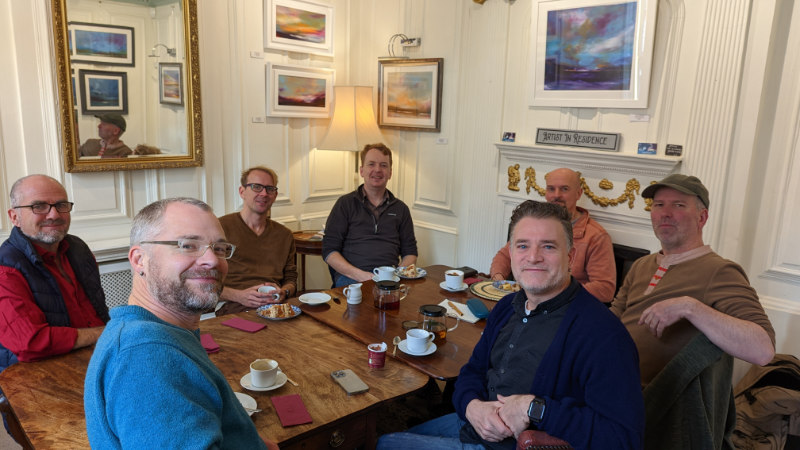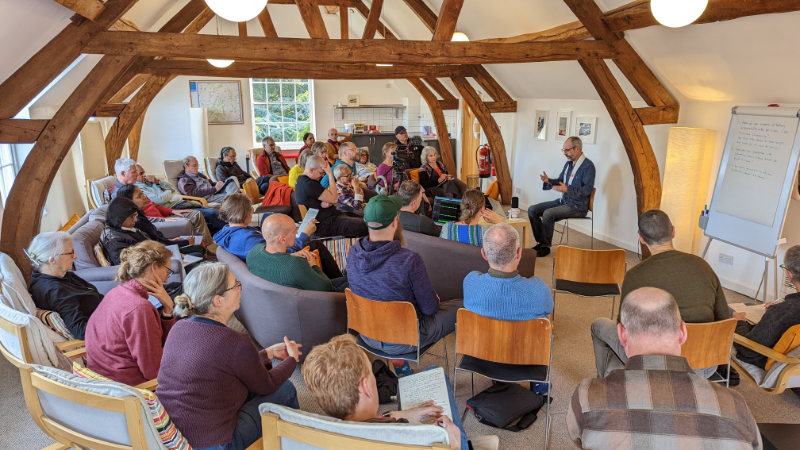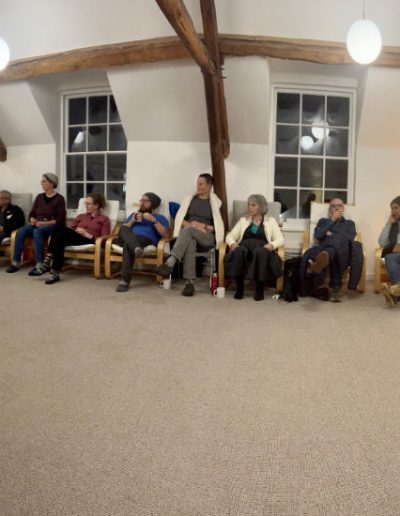2022 in-person meeting at Adhisthana
34 delegates and guests gathered for 8 full days to review the IC, clarify its main purpose, renew our priorities and update our working arrangements. It was an inspiring example of Sangha working together with a high level of purpose, sensitivity and cooperation.
The video (at 4 mins 10 secs) includes Arthavadin’s ritually taking up of his Convenor role by taking possession of one of Bhante’s malas. This has become the symbol of this office and will, in time, be passed on to Arthavadin’s successor.
Vision: a review of the IC & defining its main purpose
This was the first comprehensive review since the founding of the
International Council in 2011. Since then much has changed – both inside and outside Triratna. Consequently, this timely review aimed to ensure that the International Council adapts and continues to work in ways that are responsive, focused and relevant to the needs and aspirations of the world-wide Triratna community.
Why review the IC?
For over a decade the International Council has played an important role in cohering and developing the worldwide Triratna community. For example it:
- created the now widely recognised
- guidance on What is a Triratna Centre?
- initiated the Sikkha Project to develop an integrated programme of progressive spiritual training
- instigated the new role of International Movement Coordinator to unify and grow the Triratna Movement across the world
- is currently working to deliver a joined-up communications strategy for Triratna
Despite these and other successful achievements, a review of the International Council was considered necessary to:
- clarify, communicate and promote its core purpose and relevance
- identify priorities that are truly strategic with the aim of securing Triratna’s future vitality, sustainability and growth worldwide, and which can be used to inform FutureDharma’s funding decisions
- update the working arrangements in the light of changes (such as the creation of the International Council Convenor role) to ensure that they remain fit for purpose.
What we did
The meeting comprised of 5 parts:
1. Connecting with ourselves and others.
Aims: to encourage intimacy, trust, and comfort
- welcome, introductions & dedication ritual
- mixed Area/Strand chapter meetings
- talk ‘Serving the Bodhisattva’ (Nagapriya) exploring the relationship between the lineage of responsibility and the Bodhisattva ideal followed by discussion in chapters
2. Preparing the Ground
Aims: Establish a shared/collective perspective on the challenges to Triratna’s future health and vitality
- a brief history of the founding and structure of the IC
- rational for the current review of the IC
- recapitulation of how decisions would be made at this meeting in accordance with (then) current working arrangements
- explorations and SWOT (strengths, weaknesses, opportunities, threats) analysis of current and emerging challenges for the future health and vitality of each of each Strand followed by presentations and a synthesis of emerging themes
- introduction to the IC Steering Group followed by brief update presentations on: IC website development, IC becoming a charitable structure, Ethics & Safeguarding Working Group, Ahimsa Kula, Communications Working Group, introduction to the proposed work of the newly appointed International Movement Coordinator, application for funding an International Communications Officer, Grasping the Nettle (Sustainability) Group.
3. Vision
Aims: Establish a clear and concise vision of the IC’s purpose and aspirations to inform the range and scope of its activities, the setting of strategic objectives, and publicising its existence and relevance to the Triratna community
- explanation of why it is important to clarify a vision/purpose statement for the International Council
- introduction and review of existing IC aims
- exploration of the following questions:
– what can the IC do that other Triratna structures cannot?
– what value does/could it add to Triratna?
– what does the IC need to do to realise its full potential?
– do any IC aims need amending/changing?
– complete the sentence: the IC will be successful if….
– in one sentence, using clear and concrete language, what exactly is the purpose of the IC?
- collective discussion and synthesising of common themes until settling upon a consensually agreed statement.
4. Transformation
Aims: identify the key strategic issues confronting the future vitality, sustainability and growth of Triratna around the world with a view to informing the generation of strategic priorities that focus attention, energy and resources on what is most important
- presentation (Nandavajra) on the financial ecology of Triratna, the role of FutureDharma and how IC strategic priorities inform funding decisions
- four brief presentations (Jnanacandra, Ratnavyuha, Bodhivamsa and Aryajaya/Saraha) to stimulate thinking around the challenges facing Triratna and inform the generation of strategic priorities
- chapter meetings over 1.5 days to generate strategic priorities
- plenary presentation and merging/conflation of similar priorities
- review of generated priorities
- vote on priorities to be adopted by the IC
- private ballot to determine relative importance of the adopted priorities
5. IC Structure & Working Arrangements
Aims: Explore how the IC can become a more agile, responsive ‘fit for purpose’ structure that meets the needs of Triratna and individual members.
- Members read document detailing current working arrangements alongside changes suggested by the IC Steering Group and note any objections, questions etc.
- systematic collective working through and agreement of working arrangements and suggested changes
- key questions for discussion/exploration to clarify:
– the role and function of the IC Convenor
– the hierarchical status of the IC – College, Order, Movement
– whether or not IC members are ‘representatives’
– the role and status of Mitra Convenors at the IC
– the status of IC decisions – does the IC make decisions, recommendations, provide guidance…or all three?
– the role and status of IC working groups – who commissions them, can sit on them, and who are they answerable to?
– what constitutes ‘enough’ consensus for an IC recommendation/guidance?
– the most efficient and effective way for the IC to meet: who, where, when and how?
3 videos – hover over video to access control arrows >
- Nagapriya’s talk ‘Serving the Bodhisattva’
- Considering the IC’s achievements and the need to review
- Short updates on current projects (website, IC as a charity, Ahimsa Kula, Communications Working Group, International Movement Coordinator)
The International Council brings together the perspectives of those holding key responsibilities across the Triratna community to develop strategy, provide guidance, and enable collaborative decision-making worldwide
Strategic priorities: securing Triratna’s future vitality, sustainability and growth
To get people thinking, we heard from Jnanacandra, Ratnavyuha, Bodhivamsa and the Order Convenors (see video).
Something about the process?
The IC has always generated priorities to inform its focus and actions. With only 1.5 FTE paid staff and no additional funds of its own to commission projects, it has necessarily relied upon the goodwill, cooperation and collaboration of its membership, and others co-opted onto working groups, to progress its priorities.
Several years ago, the European Chairs Assembly incubated the development of FutureDharma as a Triratna funding body. This has been a very successful initiative. FutureDharma comprised its body of trustees in alignment with the IC’s three strand (College, Order and Movement) structure. And, in recent years, it has explicitly referenced the IC’s priorities to create criteria for the allocation of funding. This important change effectively increased the strategic influence of the IC – a change that obviously needed to be acknowledged considered by the IC in the development of its new (and/or revised) priorities.
In 2021 the IC Steering Group consented to the formation of an informal ‘Grasping the Nettle’ Group to begin exploring and drawing out some of the knotty issues relating to Triratna’s sustainability as a worldwide spiritual movement. This group, which will present its reflections and ideas to the IC Steering Group in 2023, is clear that sustainability needs to be considered alongside (spiritual) vitality and growth. All three aspects of this triad must be addressed if Triratna is to thrive. At the October/November meeting, the IC was asked to develop and propose strategic priorities with this in mind.
To prepare the membership for this task, Nandavajra, Director of FutureDharma, presented his understanding of how money flows around Triratna, and FutureDharma’s/the IC’s place in that process. This was followed by four separate presentations intended to raise awareness of the current and emerging strategic challenges facing our worldwide movement. The membership had time to reflect on what they’d heard, both alone and in discussion with their chapter brothers and sisters, before together developing and proposing strategic priorities to the IC. Duplicated or significantly overlapping priorities were conflated which resulted in ten proposed priorities, all of which were adopted by the IC in a public vote.
The final phase of this process involved weighting the relative importance of the priorities. This was necessary to give greater focus and direction to the IC’s work (and FutureDharma’s funding criteria) over the next few years and was achieved through a private ballot. Each IC member was allocated five votes of decreasing value. The first was worth five points, the second was worth four points and so on. Members cast their five votes according to what they thought would most significantly contribute to the future vitality, sustainability, and growth of Triratna. Ballots were collected, votes (points) were added up and checked before results were declared and recorded. During this process a plea was made for the conflation of two closely related priorities. This was put to a vote of the membership and was unanimously accepted, reducing the final number of strategic priorities from ten to nine.
The results of the prioritisation
The following provides the order and summary descriptions of the IC’s agreed strategic priorities:
1. Lineage of responsibility and leadership development – develop and support those who are suitable, willing and able to hold (formal) positions of responsibility within Triratna and establish of a culture of effective decision-making
2. Communications – fulfil the aims and objectives of the joined-up IC Communications strategy – informing, encouraging harmony within our community, promoting Triratna and what it offers to existing and new audiences, and engaging with the media when they cover Triratna
3. Young people – continually attract and develop young people for a Dharma life within Triratna
4. Wealth creation and management – generate, liberate, and invest financial resources to fund Triratna’s essential infrastructure, development and growth
5. Situations of transformative intensity – create new opportunities for Triratna Buddhists to live, work and be together in other ways that significantly deepen their experiences of kalyana mitrata and practice of the Dharma
6. Internationality – create the means for information and inspirations to flow across languages and national boundaries
7. Diversity of all kinds – cultivate an inclusive culture that is open, inviting and welcoming to everyone who wants to learn and practice the Dharma (as interpreted by Sangharakshita) in harmony with others
8. Dharmic engagement with social/ecological issues – support, encourage and develop a specifically Dharmic vision of, and approach to, social/ecological change
9. Deepening understanding and trust between the three strands – encourage and support harmony within and between the College, Order and Movement; and deepen confidence in our shared path of practice
What next?
The strategic priorities will:
- be further clarified and defined,
be publicised and promoted across Triratna - inform the focus and agenda of IC meetings
- inform and focus the development of the IC’s (and hopefully others’) activities, projects, and initiatives
- provide a common basis for cooperation and collaboration between different Triratna bodies/structures
- inform FutureDharma’s funding criteria
2 videos:
- Arthavadin on leadership; current priorities; Nandavajra on how Future Dharma prioritise their funding
- short talks on emerging issues & challenges from Jnanacandra, Ratnavyuha, Bodhivamsa and the Order Convenors (Aryajaya & Saraha)
Nandavajra’s presentation (see video above) showed his understanding (not anything ‘official’) of Triratna ‘ecology’ or ‘economy’ in a diagram. You can download it here but please don’t share it outside the IC.
Updating our working arrangements
Not the most exciting thing perhaps, but many remarked how enjoyable they found working through a long document together!
The revised working arrangements can be found here.
Why necessary?
The IC’s working were established in 2011. Since then:
- the role of Indian Area Movement Coordinator was created and appointed to sit on the Steering Group
- the role of IC Convenor was created, and the IC chair subsequently delegated Steering Group chairing responsibilities to them
- the International Movement Coordinator was created and appointed to sit on the Steering Group
- four mitra convenors – two from India and two from the rest of the world – have been invited to be members of the IC
- where centre/TBRL/retreat centre chairs have not been available to sit on an Area Council, mitra convenors have taken their place
- during the Covid 19 pandemic the Zoom platform was expediently used (and has continued to be used) to host some IC meetings
- the IC has begun to move towards becoming a charity requiring a robust governance structure (working arrangements)
- several ambiguities, inconsistencies and omissions have been identified in the current working arrangements
All of the above necessitated the need for a comprehensive review and updating of the working arrangements to ensure that they remain accurate, ‘fit for purpose’ and true to what is actually happening on the ground.
What next?
The revised working arrangements will be checked for accuracy and periodically reviewed by the IC Convenor to ensure that they remain relevant and fit for purpose.
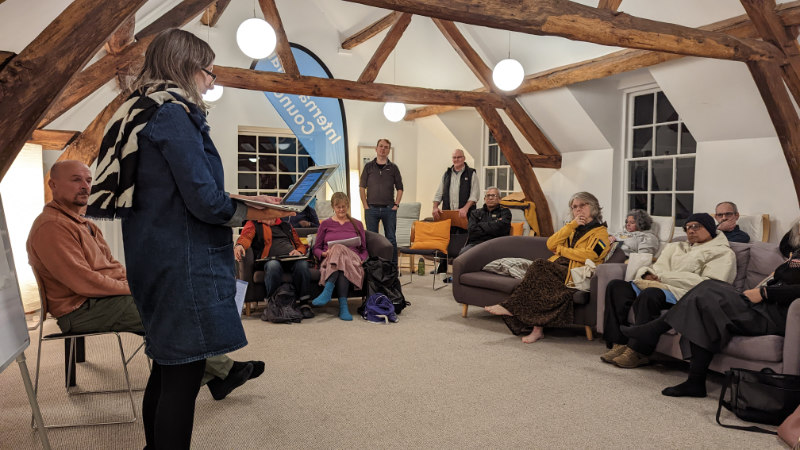
Some of the delightful people
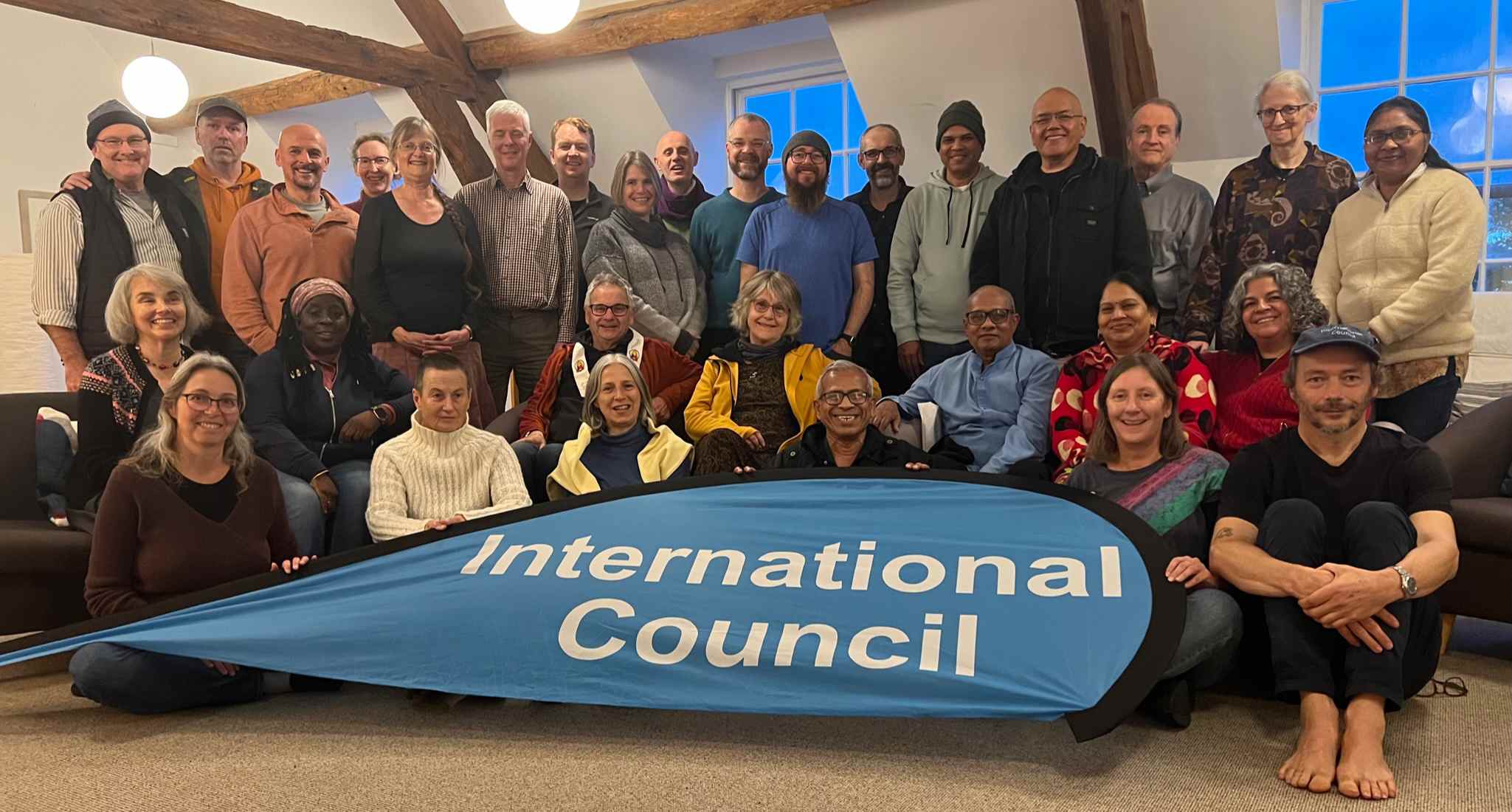
Left to right: Ratnavyuha, Subhadramati, Jnanacandra, Aparajita, Arthavadin, Jayadevi, Suvarnadhi, Viryanaya, Ratnadharini, Shantigarbha, Vajrasura, Bodhivamsa, Dhiramani, Aryadrishti, Dharmashalin, Jnanadhara, Suvarnacandra, Viryanaga, Amrutasiddhi, Nagapriya, Nagaketu, Dharmadarshi, Medhavin, Prajnasakhi, Aryajaya, Viradhamma, Saddharuci, Gunabhadri, Saraha, Abhayadana. (Kulanandi had to leave a little early)

